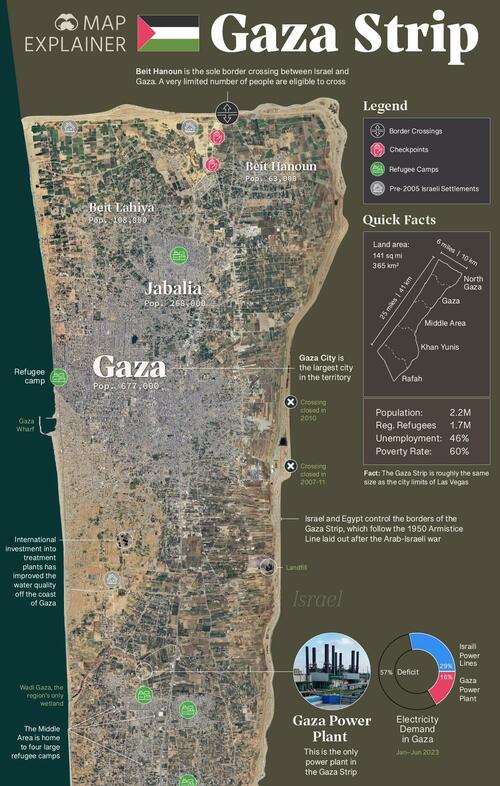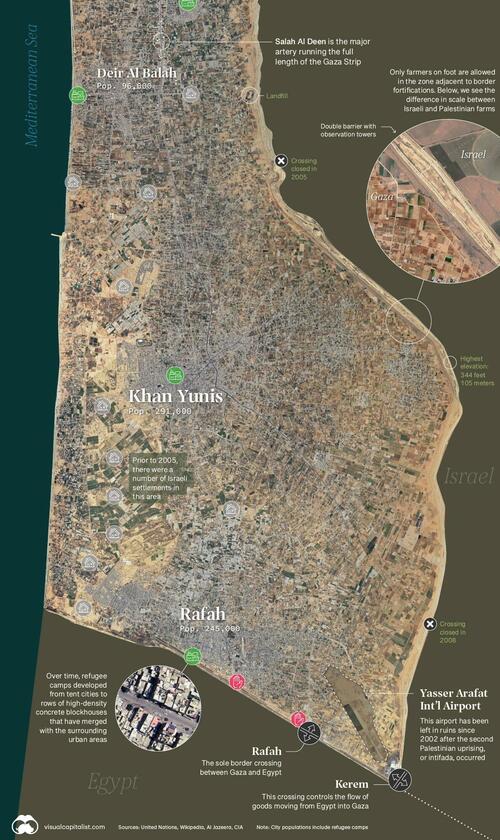Map Explainer: The Gaza Strip
Recent attacks on Israel by Hamas have placed the Gaza Strip firmly in the spotlight of the global news cycle.
While conflict in that part of the world is thoroughly covered in headlines and news stories, more basic facts about Gaza receive less attention.
With this infographic, Visual Capitalist’s Nick Routley fills in some of those gaps, including demographics, infrastructure, and more.
Below, we outline three key facts to know about the Gaza Strip and the people who live there:
1. Gaza is Young and Increasingly Crowded
Gaza has a high fertility rate (3.9), and as a result, nearly half of the people living there are children. Much of this rapidly growing population lives in crowded cities and camps that are some of the most densely populated areas in the world.
The majority of people in the Gaza Strip are officially considered refugees by the UN. Over many decades, refugee camps have become permanent settlements, blending with the surrounding urban areas. Upwards of 80% of the population relies on international aid for basic services and sustenance.
In terms of religion, Gaza is very uniform. 99% of the population are Sunni Muslims. This is similar to Egypt and other North African nations.
2. The Territory is Tightly Controlled
Israel has enforced a land, air, and sea blockade since 2007, when Hamas took control of the Gaza Strip and Israel’s Security Cabinet labeled region a “hostile entity”. The land border of Gaza Strip is heavily fortified consisting of double-wired fencing and concrete barriers. These borders follow the “Green Line”, a demarcation set after the end of the Arab–Israeli War. There is also a 100-300 meter buffer zone inside the territory’s border where access is restricted.
There are two border crossings—one into Egypt in the south and one into Israel in the north—that a limited number of civilians can cross. Over the years, border crossings on the east side of the territory have been closed down. There is an additional large scale crossing on the bottom corner of the territory that serves as a checkpoint for goods entering from Egypt.
The region’s airspace is controlled by Israel. Even its electro-magnetic space is restricted, meaning many Palestinians rely on 2G and 3G.
3. Infrastructure is Patchy
Multiple years of conflict and underinvestment have left infrastructure in shambles in much of the Gaza Strip.
For example, there is a just single diesel power plant servicing the entire region. Power lines run into Gaza from neighboring Israel, but even in non-conflict periods, the region runs a large electricity deficit.
Gaza accesses fresh water via the Coastal Aquifer—an underground water supply that is dwindling due to over-extraction—and from desalination plants. International aid efforts are improving the situation, but infrastructure remains damaged by neglect and intermittent air strikes.
Water treatment infrastructure has slowly been improving due to foreign aid, and less raw sewage is now entering the Mediterranean Sea. This clean-up effort has helped create more recreation opportunities along the territory’s beaches.
Tyler Durden
Thu, 10/12/2023 – 23:00 Source
 RSS Feed
RSS Feed















 October 13th, 2023
October 13th, 2023  Awake Goy
Awake Goy 

 Posted in
Posted in  Tags:
Tags: 













